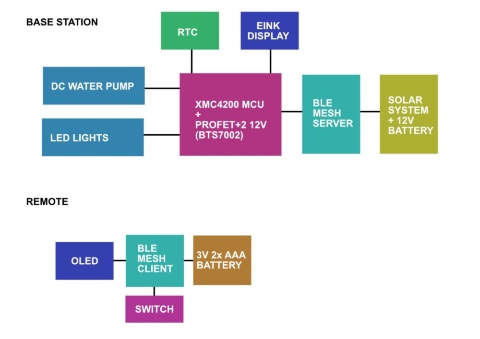Community Activities
Element14 Design Challenge :
Sustain the World with 'Smart Farm Hoe'
Infineon and the element14 community have come up with another exciting Design Challenge that will speak to your creativity and imagination.
The winner price goes to Ashok, also known as user “Asokfair”. He finished and won the Element14 Design Challenge with his project “Smart Farm Hoe”. The aim is to “Sustain Our Planet” with innovative, inspiring designs featuring the following challenge kit products from Infineon:
- Microcontroller: XMC4200 Platform2Go kit
- Motor control: DC Motor Shield TLE94112 for Arduino
- Sensing: Shield2Go Pressure Sensor DPS368
- Sensing: Shield2Go 3D magnetic sensor TLV493D
- Smart switching: High current PROFET™ +2 Shield with BTS7002 for Arduino
The winner Ashok demonstrated in 10 blogs his idea and explained each concept behind the project. Ashok has a background on agriculture due to his family. He is concerned about the fast decrement on farmers and people interested in working for agriculture. “15 years back I had the idea of adding LED lights into the hoe to help the farmers during night time, and today I have this smart hoe to control the water flow and lights.” – Ashok expressed in his blog and decided to create a solution that will encourage farmers and make their experience more efficient.

The Smart Hoe Set-Up
The Smart Farming Hoe has two setups, 1. Base Station and 2. Remote. The base station is built with Infineon XMC4200 Platform2GO kit and PROFET 12V Switch Shield. The Cypress BLE MESH kit is interfaced to XMC4200 over UART communication. The Base Station is powered through 12V 7.5Ah battery. This battery is changed via 20watt solar panel with a luminous controller, a 12V DC submersible water pump and 12V LED's that are connected to PROFET+2 that switched outputs.

The remote is built with the BLE MESH Kit and an OLED display is used for the user interface. The remote can be used for the control of mode changes. This setup is powered via AAA battery with a removable battery holder attached in it. This entire setup is wrapped into the small size Wooden Hoe. Ashok also explains that it is just concept demonstration and that in practical scenario this setup will be embedded inside the wood.
Functionality:
The base station MESH kits act as a server. It receives the data from the client - Smart Hoe- and sends to the XMC4200 kit over UART communication. The XMC4200 MCU processes the UART data and controls the port pins based on the data status. An RTC is used to control the timer and E Ink display shows the status of the system. In addition, the battery information charging status can be monitored wirelessly but is currently not implemented.
The Smart Hoe works with the MESH kit, as it acts as a client and sends the data on button status change. A small button press can change the state of the Light or Motor. A 3 second button press can change the modes (light, motor and timer) As well as, some of the features that could be added in future like sensing soil, plants or other materials.
Some examples on functionality of this machine are:
- Farmers can control the water flow.
- Outdoor lights control for home gardening
- Sensors of the Hoe
Smart Farming Hoe
For information, check out Ashok´s Blog video
GitHub

See the experimental code if you are interested in interacting with this project.
The way to a smarter, safer and more convenient future with Infineon’s 2Go kits and shields
Element14 Presents :
Infineon Smart City Model with Clem
At the beginning of 2020, Infineon showcased various dedicated solutions, all designed to illustrate new design challenges on the road to a smarter, safer future. The idea is to help designers meet these challenges by optimizing their abilities in these areas.
Working in close collaboration with element14, one of the world’s largest electronic design communities, Infineon launched several challenges putting creative engineers to the test. Read more to see how makers and engineers developed sustainable project concepts and ideas by building on Infineon’s prototyping kits.
Flagship project for smart city
This community engagement included a reference project with Clemens Mayer. Also known as MayerMakes, Clemens is a full-time maker and technology enthusiast. See how MayerMakes built his first “smart city” model for Infineon using the new range of powerful Arduino-compatible 32-bit ARM® Cortex® boards, motor driver shields, and sensors.
Showcased on element14 presents, Clem’s fun “save our planet” demo features several Infineon kits plus XMC™ microcontrollers and XENSIV™ sensors. This demo challenges the user to a race against the clock and find an active charging station before their e-car runs out of power. Follow the story of MayerMakes and find out why it is so important to work on smart city models.
The following products from Infineon were used:
- XMC4700 Relax kit
- H-Bridge Kit 2Go
- DC Motor Control shield TLE 94112EL
- DC Motor Control shield BTN 8982TA
- XENSIV™ TLV493D 3DSense Shield2Go
- XENSIV™TLI 4970 Current Sense Shield2Go
Complementing our various challenges and reference projects, we also regularly run road-tests. These community projects give early adopter enthusiasts a chance to review and rate our products ahead of the field.
Element 14 Roadtest :
Infineon BLDC Shield + XMC 4700 Relax Kit + Motor - Review
Infineon and element14 were invited for a RoadTest, applicants received an Infineon BLDC motor control shield and a complementary XMC 4700 Relax Kit.
The BLDC shield is a high-current motor control board compatible with Arduino. It is equipped with three smart IFX007T NovalithIC™ half-bridges to drive one BLDC motor, one or two bi-directional DC motors or up to three uni-directional DC motors. It comes with extensive diagnostic and protective features. The shield is also compatible with the complementary XMC 4700 Relax Kit, giving designers instant access to the powerful capabilities of the XMC4700-F144 microcontroller based on a 144 MHz Arm® Cortex®-M4 with 2 MB flash and 352 KB RAM.
Downloads
-
Review of Infineon BLDC Shield, XMC 4700 Relax Kit & Motor
01_00 | Aug 25, 2021 | PDF | 1.78 mb



